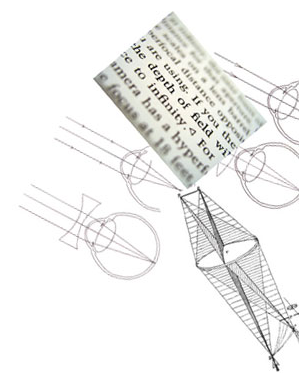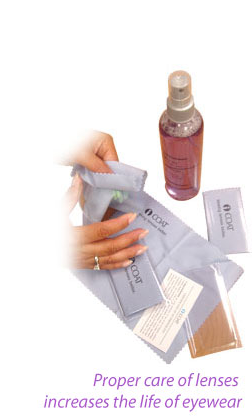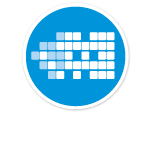iHealth
Eye Conditions
Hyperopia, also known as farsightedness or long-sightedness, is a defect of vision caused by an imperfection in the eye (often when the eyeball is too short, cornea is too flat or when the lens cannot become round enough), causing an inability to focus on near objects or close reading, and in extreme cases causing a sufferer to be unable to focus on objects at any distance. As an object moves toward the eye, the eye must increase its power to keep the image in focus on the retina.
Plus lenses are used to correct farsightedness and are thicker in the center and thinner of the edges. An AR coating is recommended to reduce the appearance of magnification.
Astigmatism is a vision condition that causes blurred vision due either to the irregular shape of the cornea, the clear front cover of the eye, or sometimes the curvature of the lens inside the eye. An irregular shaped cornea or lens prevents light from focusing properly on the retina, the light sensitive surface at the back of the eye. As a result, vision becomes blurred at any distance.
Lenses with a “compound prescription” are used to correct astigmatism. These lenses have a spherical power to correct nearsightedness or farsightedness, and a cylinder power to correct the blurriness caused by astigmatism.
Presbyopia is a vision condition in which the crystalline lens of your eye loses its flexibility, which makes it difficult for you to focus on close objects.Symptoms of Presbyopia are difficulty reading fine print, particularly in low light conditions, eyestrain when reading for long periods, blur at near or momentarily blurred vision when transitioning between viewing distances.
Presbyopia is generally corrected with progressive lenses, lined bifocal lenses, trifocal lenses, or simple reading glasses.
Because the effects of Presbyopia continue to change the ability of the crystalline lens to focus properly, periodic changes in your eyewear may be necessary to maintain clear and comfortable vision.

Reducing Glare
While AR provides relief from glare off the back of the lens, there are several featured lenses that reduce or eliminate glare from passing through the lens. These include:
- Tinted Lens – The color of the tint determines the parts of the light spectrum that are absorbed by the lenses. Manufacturers use different colors to produce specific results.
- Polarized Lens – Polarized filters are most commonly made of a chemical film applied to a transparent plastic or glass surface. The chemical compound used will typically be composed of molecules that naturally align in parallel relation to one another. When applied uniformly to the lens, the molecules create a microscopic filter that absorbs any light matching their alignment
- Photochromic Lens – Sunglasses or prescription eyeglasses that darken when exposed to the sun are called photochromic lenses, or sometimes react-to-light lenses.
- Mirror Lens – The mirror lenses have a reflective coating applied in a very thin, sparse layer — so thin that it’s called a half-silvered surface. The name half-silvered comes from the fact that the reflective molecules coat the glass so sparsely that only about half the molecules needed to make the glass an opaque mirror are applied.
Your Prescription
Spherical component in a lens includes spherical correction in diopters for each power specification. Powers can be convergent (ex. +3.00D) to correct Hyperopia or divergent (ex. -4.75D) to correct Myopia. If neither convergence nor divergence is required in the prescription, “Plano” is used to denote a refractive power of zero.
Cylindrical component is used when the patients need two different correction powers in two different meridians (horizontal and vertical). This is specified by describing how the cylinder differs from the sphere power. Power evenly transitions between the two powers as you move between the meridians.
The axis component defines where the two powers (sphere and cylinder) are located. The sphere is almost always 90 degree from the cylinder.
Benefits of Sunglasses
- Sunglasses provide protection from ultraviolet rays in sunlight.
Ultraviolet (UV) light damages the cornea and the retina. Good sunglasses can eliminate UV rays completely. - Sunglasses provide protection from intense light.
When the eye receives too much light, it naturally closes the iris. Once it has closed the iris as far as it can, the next step is squinting. If there is still too much light, as there can be when sunlight is reflecting off of snow, the result is damage to the retina. Good sunglasses can block light entering the eyes by as much as 97 percent. - Sunglasses provide protection from glare.
Certain surfaces, such as water, can reflect a great deal of light, and the bright spots can be distracting or can hide objects. Good sunglasses can completely eliminate this kind of glare using polarization. - Sunglasses eliminate specific frequencies of light.
Certain frequencies of light can blur vision, and others can enhance contrast. Choosing the right color for your sunglasses lets them work better in specific situations.
When you buy a pair of cheap sunglasses, you often give up all of these benefits and can even make things worse. For example, if your sunglasses offer no UV protection, you increase your exposure to UV rays. The cheap sunglasses block some of the light, causing your iris to open to allow more light in. This lets in more of the UV light as well, increasing the damage UV light can cause to the retina.
Buying the right pair of good sunglasses for the conditions in which you use them gives you maximum protection and performance.
Choosing the perfect Sunglass
The key to finding the perfect pair of sunglasses is to pick the right features for your situation. Here are some of the most important features, in addition to the type of lens to choose from, to compare when you buy a pair of sunglasses:
- Lens darkness – What you plan to use the sunglasses for determines the darkness of the tint. For outdoor sports such as mountain climbing and snow-skiing, you want a tint that blocks most light. You can buy sunglasses that block up to 97 percent of light. For most purposes, like going to the beach or driving, look for a tint that absorbs or blocks 70 percent to 90 percent of light. Tints that offer less than 60-percent blockage are mainly good for fashion since they offer only mild protection.
- Special coatings or features – Anti-reflective, hydrophobic, oleophobic, mirror and scratch-resistant coatings improve the functionality of the sunglasses but also add cost. Many of the more expensive sunglasses use specific technologies including polarization, tinting and anti-reflective coatings to achieve increased clarity, better protection, higher contrast or to block certain types of light.
Lens Materials
The characteristic of a lens material is typically defined by 3 material properties:
1. Abbe Value – Clarity of the material
2. Refractive Index – Thickness of the material
3. Specific Gravity – Weight of the material
The Abbe Value, in general, refers to the “Optical Clarity” of a lens. It is a number that describes the amount of chromatic aberration (tendency of a materiel to separate light based on varying wavelength) of an ophthalmic lens material. The higher the Abbe Value of a lens, the lower chromatic aberration. The lower the chromatic aberration, the better the clarity.
The Refractive Index (or index of refraction) of a medium is a measure for how much the speed of light is reduced inside the medium. In other words, it is a measure of the bending (refraction) of a ray of light on entering a medium. A lens material with a higher Index of Refraction will bend more light and will require less of a curve to achieve a specific Rx. Surfacing with less curve for a given Rx will help keep the lens thinner. Higher index lenses typically have a higher specific gravity, due to the increased material density.
Specific Gravity is the ratio of density of a lens material to the density of water. The higher the specific gravity of a lens material, the higher its density will be. So for a given power, the lower the specific gravity the lighter the lens will be.
| Material, Plastic | Index | ABBE | Specific Gravity |
| Transitions Plastic | 1.50 | 58 | 1.27 |
| CR-39 Hard Resin | 1.50 | 58 | 1.32 |
| Trivex | 1.53 | 44 | 1.11 |
| Spectralite | 1.54 | 47 | 1.21 |
| Ormex | 1.56 | 36 | 1.23 |
| Polycarbonate | 1.59 | 30 | 1.20 |
| Hi-Index 1.60 | 1.60 | 42 | 1.22 |
| Hi-Index 1.67 | 1.67 | 32 | 1.35 |
| Hyperview 1.66 | 1.66 | 32 | 1.37 |
| Hi-Index 1.70 | 1.70 | 39 | 1.41 |
| Hi-Index 1.74 | 1.73 | 33 | 1.47 |
| Crown Glass | 1.523 | 59 | 2.54 |
Lens Materials
- Glass – Is the historic choice of ophthalmic lenses, is the most stable, scratch resistant material, and provides the clearest optics of all lens materials. However, since glass is more brittle, less impact resistant (unsafe in case of accidents) and heavier than other lens materials, it is no longer the choice of many eye glass wearers, especially patients with higher prescriptions. Over the years, the variety of glass lens styles has also greatly diminished.
- Plastic – Also known as hard resin or CR39 is approximately 50% lighter than glass and comes in the widest variety of lens styles of any material. CR39 is far less scratch resistant than glass and therefore benefits greatly with a quality scratch resistant coating. Approximately 60% of lenses sold in the US today are made from hard resin. Hard Resin lens materials do not include UV protection and hence require a UV coating for protection from harmful ultra violet light.
- Polycarbonate – Polycarbonate is one of the thinnest and lightest materials available. Polycarbonate offers very high impact resistance and a refractive index of 1.59. It is usually preferred over conventional hard resin because of its impact resistance and lighter weight. Polycarbonate material blocks both UVA and UVB and offers availability of most lens styles. Due to the material characteristics Polycarbonate has a lower Abbe value.
- Trivex – Trivex is a newly developed polymer that combines the impact resistance of polycarbonate, exceptional optical clarity with an Abbe Value of 45, and a specific gravity of 1.11 (the lightest material available). Trivex has excellent tensile strength making it an ideal choice for rimless frames.
- Mid-Index – Generally considered to be any index above Trivex (1.53) but below polycarbonate (1.59). Mid-index lenses are generally considered in the same family. Product characteristics and lens style availability vary depending on manufacturer.
- 1.54
- 1.55/1.56
- Hi-Index (generally considered any index 1.60 or above) – Hi-Index materials provide flatter surfaces, reduced magnification or minification and help maintain a thinner lens profile. Hi-Index materials, however, typically have a lower Abbe Value and could potentially affect patients who are sensitive to chromatic aberration. In general, the higher the index of refraction the thinner the lens. Although Hi-Index may provide a thinner lens due to its high density, it may not be the lightest. Product characteristics and lens style availability vary depending on manufacturer.
- 1.60
- 1.66/1.67 – the difference in 1.66 and 1.67 is in the way the index of refraction is measured, not in the material itself.
- 1.70/ 1.71
Lens Types
- Aspheric – Aspheric lenses are ideal for strong prescriptions because they are flatter and thinner. Aspheric lenses have a flatter curve toward the periphery of the lens. This eliminates many of the aberrations of the periphery of the lens and permits a greater field of vision. Aspheric lenses provide slightly improved vision over ordinary lenses and offer better cosmetics because they lessen eye magnification and minification.
- Spherical – Spherical lenses have a spherical front curve and can correct for many Rx specifications. Powers can be convergent (ex. +3.00D) to form a convex lens and correct Hyperopia or divergent (ex. -4.75D) to form a concave lens to correct myopia. If neither convergence nor divergence is required in the prescription, “Plano” is used to denote a refractive power of zero. A Plano Rx has the same front and back curves.
A lens where upper portion corrects distance vision, while the lower portion corrects the near vision. Lined bifocals have a segment line separating the distance from the near. The shape of the bifocal may vary but the traditional lined bifocal is a Flat Top 28 with a segment area 28mm wide. Based on the curvature of the segment lines, Bifocals are categorized in Curve Top (curved segment line), Flat Top (flat segment line) and Round (rounded segments line). Furthermore, bifocals come in at least three sizes of segments 28mm, 35mm and 45mm widths. Round segments come in 22mm, 25mm and 28mm diameters.
Trifocals are similar to bifocals except they offer two separate power “near” zones. The third zone, placed just above the bifocal zone offers intermediate correction for distances further than reading but less than distance (such as a computer screen) Trifocals are also designed in at least 3 varying widths: 28mm, 35mm and 45mm wide.
Progressives lenses gradually increase in power as the line of sight travels downward through the lens. The main drawback of such lenses is that the vision on either side of the vertical line through the optical center produces unwanted, unprescribed cylinder power, causing some potential periphery distortion or aberrations. Newer computerized designs or freeform surfacing of progressive lenses offer the ability to all but eliminate this unwanted distortion.
- Computer lenses – Computer Lenses are specialty lenses with greater intermediate viewing distances specifically made for reading and intermediate distances.
- Occupational Lenses – Occupational lenses are lenses designed for specific jobs, hobbies, and usage and offer a variety of focal areas specific to the wearer.
- Cataract – Cataract lenses are specialty lenses prescribed following cataract surgery. These lenses are created to minimize both the distortions and the weight of the lenses.
- Low Vision – Low vision is a significant reduction of visual function that cannot be fully corrected by ordinary glasses, contact lenses, medical treatment and/or surgery. People with severe low vision may be classified as partially sighted and/or legally blind. Low vision lenses are specially designed high power lenses for patients with low vision.
- Double Segs – Double-D segs are flat top bifocals on the bottom and top with distance viewing in the middle. They’re a good solution for those who need to view close up not only downward, but also overhead.
Lens Coatings
Lens coatings can enhance the performance and appearance of eyeglass lenses. If you’re considering lens coatings in your next pair of eyeglasses, here’s what you should know about the following:
Just as we use sunscreen to keep the sun’s UV rays from harming our skin, UV treatment in eyeglass lenses block those same rays from damaging our eyes. Overexposure to ultraviolet light is thought to be a cause of cataracts, retinal damage and other eye problems.
An ultraviolet treatment is simple and quick to apply to most plastic eyeglass lenses, and it does not change the appearance of the lenses. The exception is polycarbonate lenses, which don’t need UV treatment because it is an inherent property of the material.
Several of the most serious eye problems can be linked to one cause: UV light. UV is separated into two categories based on the frequency and wavelength of the light: UV-A and UV-B.
As a natural protection mechanism, the cornea of your eye absorbs all of the UV-B and most of the UV-A light. But some of the UV-A light reaches the lens of the eye, and over time this absorption can lead to cataracts. The small amount of UV-A which gets past your cornea and reaches the retina, can eventually lead to macular degeneration, the leading cause of blindness in people older than age 65. Intense and prolonged exposure to UV radiation can cause either cancer of the eye or photokeratitis, which is basically sunburn on your retina.
Proper UV coating on your sunglasses can eliminate UV radiation, and you should check to make sure that your sunglasses filter out 100 percent of both types of UV rays.
No eyeglass lens material – not even glass (most scratch resistant material) – is scratch-proof. However, a lens that is treated front and back with a clear, hard coating does become more resistant to scratching, whether it’s from dropping your glasses on the floor or occasionally cleaning them with a paper towel. Kids’ lenses, especially, benefit from a scratch-resistant hard coat.
Today most types of plastic lenses, including high-index, polycarbonate and traditional plastic materials have built-in scratch-resistant coatings. Since scratch-resistant coatings are sometimes optional, make sure your optician knows that you want them in your prescription eyeglasses.
Since a scratch-resistant coating can’t completely protect your lenses from wear and tear, keep your glasses in a cushioned case, and clean them with a microfiber cloth and the cleaning solution your optician recommends.
Scratch resistant coatings are films made from diamond-like carbon and polycrystalline diamond materials. Through a process of ionization, a thin but extremely durable film is applied on the surface of the lens that protects the lens from scratching.
There are several technologies used to apply these coatings.
Application Methods :
- Spin Application – Spin coating is a procedure where a liquid coating is dropped on the center of a lens surface, which is then rotated at high speed in order to spread the coating, forming a uniform thin coat.
- Dip Application – Unlike spin coating, in a dip coating process the lens is entirely dipped is entirely dipped in a bath of coating solution under control conditions forming a uniform thin film coating on the lens surface.
Curing Methods :
- UV Curing – In the UV curing process, Ultraviolet Light (UV light) interacts with the lenses coated with scratch resistant formula to impart durability and desired scratch resistance.
- Thermal Curing – In the thermal curing process, the coated lenses are cured in an oven under controlled thermal conditions to impart preferred scratch resistance properties.
Anti-Reflective (AR) or Anti-Reflection coatings are optical coatings applied to the surface of lenses and other optical devices to reduce reflection. Anti-Reflective coatings are made of several layers of very hard thin film metal oxides that are layered on the lens surface. Each of those layers is chemically engineered to block reflected light by imparting an index of refraction that is somewhere between the index of refractions of air and glass. This causes the intensity of the light reflected from the inner surface and the light reflected from the outer surface of the film to be nearly equal, cancelling each other out through destructive interference and eliminating the glare. This increases the amount of visible light available to the eye thus improving the efficiency of vision.
You should not consider your eyeglass lenses complete unless they have anti-reflective (AR) coatings. Anti-Reflective coatings eliminate most surface reflections in eyeglass lenses (internal and external) – reflections that are both cosmetically unappealing (reduced eye contact) and can interfere with your vision.
Research has demonstrated that lenses with anti-reflective coatings provide better vision than identical lenses without anti-reflective coatings. Studies also show that people tend to be more comfortable working at a computer when wearing lenses with anti-reflective coatings compared to the similar lenses without anti-reflective coatings.
In contrast to anti-reflective coatings, which are very clear, mirror coatings are bold statements of color. Just as the name implies, a mirror coating is highly reflective (opposite to anti-reflective).
Mirror coatings are purely cosmetic and are available in an assortment of colors and the wearer perceives no difference in vision regardless of what color the coating is. Only those looking at the person wearing the glasses can see the color of the mirror coating. Mirror coatings are generally applied to sunglass tinted lenses. Obviously, a highly reflective coating prevents others from seeing the eyes of the wearer.
A common problem with sunglasses is called back-glare. This is light that hits the back of the lenses and bounces into the eyes. A backside AR coating is usually recommended with sunglasses to reduce any backside reflection (the surface of the lens nearest to the eye). Because sunglass lenses are so dark, the AR coating can wind up looking smeary on the front surface. But coating the backside of the lens with AR coating helps reduce the reflections of light that enter from behind you and bounce off the surface into your eyes. A back-side coated sunglass lens is much more comfortable than an uncoated sunglass lens.
- On prescription eyewear
In addition to regular sunglasses, mirror coatings can also be applied to the prescription eyewear. - On Sunglasses
Sunglasses are usually polarized lenses that protect your eyes from harmful sun rays and reduce reflected light or glare. By applying a mirror coating on sunglasses more harmful sunlight can be stopped from entering the eyes.
Mirror coatings come in different densities – Flash and Solid. Solid mirrors usually reflect back more light than flash mirrors. So for solid mirrors the laboratory applies more layers of the coating solution than for flash mirrors.
Eyewear Cleaning Tips
Although most of the ophthalmic lenses these days are treated with special optical treatments such as scratch resistant protection and anti-reflective protection, all lenses require careful and efficient cleaning procedures to maintain the optics of the lenses. Regular cleaning of your eyeglasses will increase the life of your eyewear while giving you the better optical clarity as compared to unclean lenses.
Here are some tips for taking care of your eyewear
- Never wipe lenses while dry. Always use water or a cleaning solution designed for AR coated lenses.
- Clean lenses daily with a mild soap and warm water, rinse and then dry with a clean soft cloth.
- Do not use paper products on your lenses. Most paper products, like paper towels, contain contaminates that can scratch your lens in addition to leaving lint.
- Avoid exposing lenses to hair spray and household spray cleaners. They may contain chemicals that can damage your lenses.
- Always store your glasses in a clean protective case when not being worn.
- Do not expose your glasses to extreme temperatures such as leaving them on the dash board of the car on a hot summer day. Extreme temperatures cause expansion and contraction of the lens materials resulting in the damage of the lenses.
















